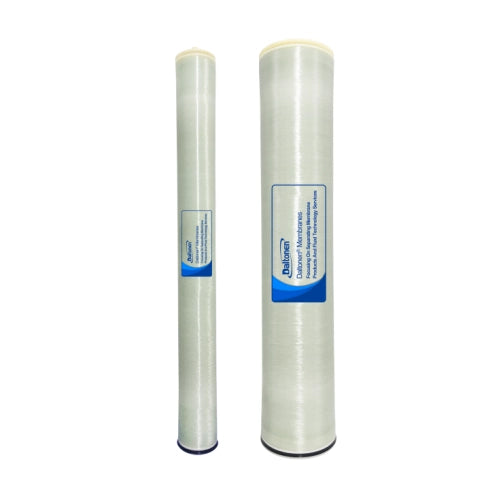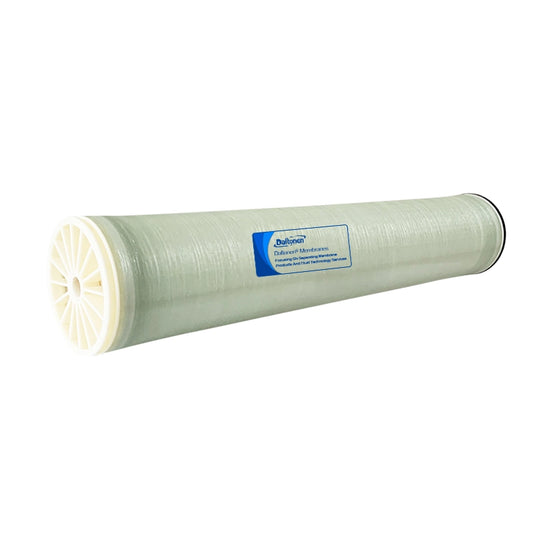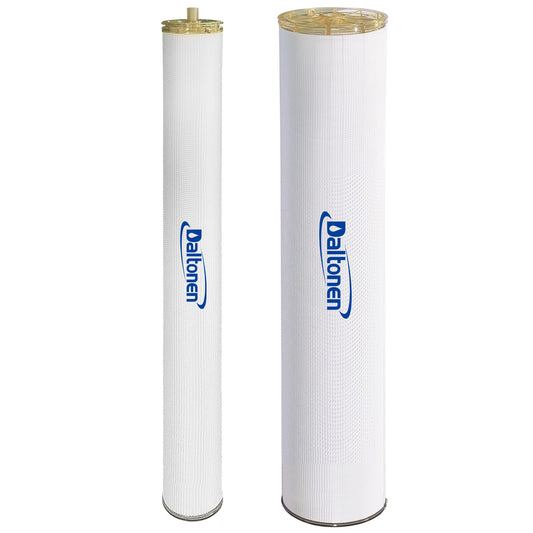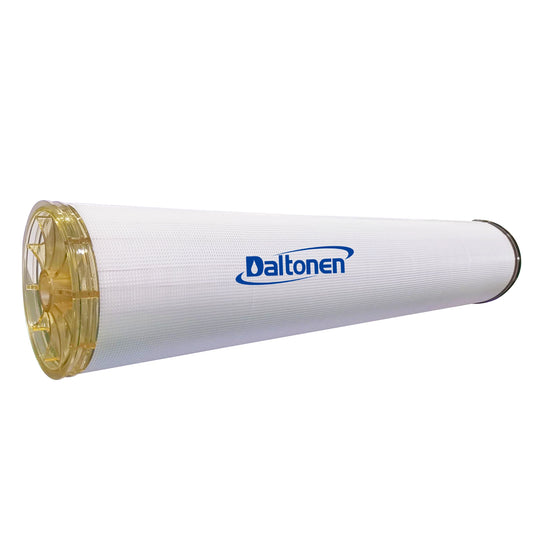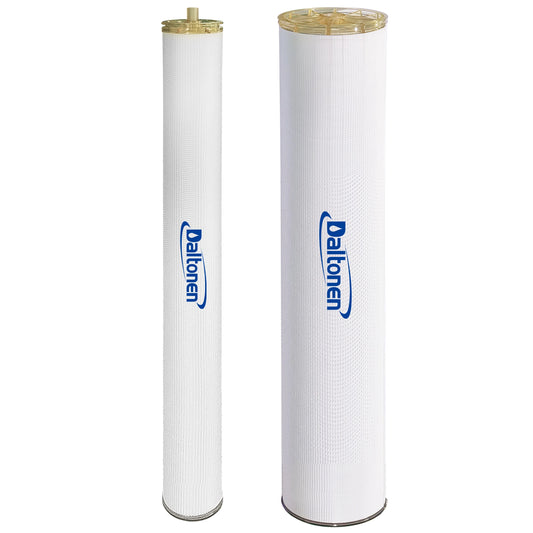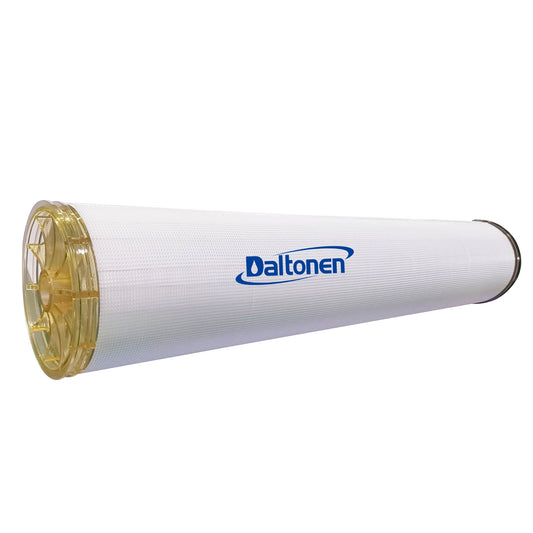A Brief Discussion on the Application of Nanofiltration Membrane in the Cosmetics Industry
28 Mar 2025
A Brief Discussion on the Application of Nanofiltration Membrane in the Cosmetics Industry
1. Overview of Nanofiltration Membrane Technology
1.1 Basic Principles and Characteristics
Nanofiltration membrane technology is a pressure-driven membrane separation technique that lies between reverse osmosis and ultrafiltration. It works by applying a certain pressure to make the solvent (such as water) and some small molecules in the solution pass through the membrane, while retaining larger molecules or ions, thus achieving the purpose of concentration and separation. With a pore size of around 1 nanometer, nanofiltration membranes have a high retention rate for divalent and multivalent ions as well as organic substances with a molecular weight over 200, yet they allow small organic molecules and monovalent ions to pass through, exhibiting selective permeability during the separation process.
In terms of characteristics, nanofiltration membranes offer high separation efficiency, effectively removing harmful substances and impurities from solutions while retaining active ingredients. For instance, in the cosmetics industry, when dealing with extracts containing various active substances, nanofiltration membranes can retain large active components like proteins and polysaccharides, allowing small impurities and solvents to pass through, thereby achieving the concentration and enrichment of active substances. The retention rate of active substances can exceed 80%, providing a strong guarantee for the efficient extraction of active ingredients in cosmetics.
Moreover, nanofiltration membranes have the advantages of relatively low operating pressure and energy consumption. Compared to reverse osmosis, their operating pressure is typically between 0.5 and 2.0 MPa, with energy consumption being only 1/3 to 1/2 that of reverse osmosis. This makes nanofiltration membrane technology more economical for application in the cosmetics industry, reducing production costs.
Additionally, the nanofiltration membrane process can be carried out at room temperature, avoiding the destruction of active ingredients by high temperatures. This is particularly important for the concentration and separation of heat-sensitive active ingredients in cosmetics, ensuring the activity and stability of these components.
1.2 Comparison with Other Membrane Technologies
Comparison with reverse osmosis: Reverse osmosis membranes have a smaller pore size, generally below 0.1 nanometers, and can almost retain all ions and small organic molecules. They are mainly used in seawater desalination and high-purity water production. If reverse osmosis technology were employed for the concentration and separation of active ingredients in the cosmetics industry, although it could yield a more purified concentrate, it would also retain some beneficial small active components for the human body, resulting in resource waste. Furthermore, reverse osmosis has high operating pressure and energy consumption, making nanofiltration membranes more advantageous in the cosmetics industry where high active ingredient requirements and cost control are priorities.
Comparison with ultrafiltration: Ultrafiltration membranes have a larger pore size, typically between 10 and 100 nanometers, and are mainly used to retain colloids, proteins, microorganisms, and other large molecules. They have virtually no retention effect on small solutes and ions. In the cosmetics industry, ultrafiltration can be used to remove large particulate impurities and microorganisms from extracts but has limited effectiveness in concentrating active ingredients. In contrast, nanofiltration membranes can not only retain large active ingredients but also remove some small impurities, achieving more effective concentration and separation. Therefore, nanofiltration membranes are more suitable for the in-depth processing of active ingredients compared to ultrafiltration.
Comparison with microfiltration: Microfiltration membranes have the largest pore size, generally between 0.1 and 10 microns, and are mainly used to remove larger particulate matter such as suspensions and bacteria. They have no retention effect on either small solutes or large solutes. In the early stages of cosmetics production, microfiltration can be used as a pretreatment method to remove suspended impurities from extracts but cannot achieve the concentration and separation of active ingredients. Nanofiltration membranes can further concentrate and enrich active ingredients based on microfiltration, allowing the two to be used in tandem to leverage their respective advantages in the cosmetics manufacturing process.

2. Application Advantages of Nanofiltration Membranes in the Concentration and Separation of Active Ingredients in the Cosmetics Industry
2.1 Maintaining Active Ingredient Stability
Nanofiltration membrane technology can effectively maintain the stability of active ingredients during the concentration and separation process in the cosmetics industry. Since the nanofiltration membrane process can be conducted at room temperature, it avoids the destruction of active ingredients by high temperatures. For example, many natural plant extracts in cosmetics contain heat-sensitive active ingredients such as certain vitamins and enzymes. Under traditional high-temperature concentration processes, these active ingredients may become denatured or degraded, reducing their efficacy. However, using nanofiltration membrane technology allows for concentration and separation under mild conditions, ensuring the structure and function of these active ingredients remain intact and guaranteeing the final effectiveness of the cosmetics. Relevant research data indicates that active ingredients processed with nanofiltration membranes can achieve an activity retention rate over 30% higher than that of traditional high-temperature processes, which is of significant importance for retaining key active ingredients in cosmetics.
2.2 Enhancing Active Ingredient Purity and Concentration
Nanofiltration membrane technology offers notable advantages in improving the purity and concentration of active ingredients in cosmetics. With a pore size of around 1 nanometer, nanofiltration membranes have a high retention rate for divalent and multivalent ions as well as organic substances with a molecular weight over 200, while permitting small organic molecules and monovalent ions to pass through. This characteristic enables nanofiltration membranes to effectively retain large active components like proteins and polysaccharides while allowing small impurities and solvents to pass through, thereby achieving the concentration and enrichment of active substances. For example, when processing plant extracts containing multiple active ingredients, nanofiltration membranes can increase the concentration of active ingredients several times over while removing impurities such as inorganic salts and pigments, significantly enhancing the purity of the active ingredients. Experimental data shows that after nanofiltration membrane treatment, the concentration of active ingredients in cosmetics can be increased by 50% to 80%, and purity can be improved by 20% to 30%. This not only boosts the quality of cosmetics but also reduces subsequent processing costs and improves production efficiency.
3. Practical Cases of Nanofiltration Membrane Application in the Concentration and Separation of Active Ingredients in the Cosmetics Industry
3.1 Concentration and Separation of Plant Extracts
Plant extracts, with their rich bioactive components, are widely used in the cosmetics industry, offering effects such as antioxidation, moisturizing, and whitening. Nanofiltration membrane technology has shown significant advantages in the concentration and separation of plant extracts.
Take rose extract as an example. Roses contain various active ingredients like flavonoids and polyphenols, which have antioxidant and skin-soothing properties. Traditional extraction and concentration methods may lead to the loss or reduced activity of some active ingredients. However, using nanofiltration membrane technology can effectively retain these large active components while removing small impurities and solvents. Experiments have shown that after nanofiltration membrane treatment, the concentration of active ingredients in rose extract increased by 60%, purity by 25%, with an active ingredient retention rate exceeding 90%.
Similarly, in processing aloe vera extract, which contains multiple polysaccharides and bioactive proteins beneficial for skin moisturizing and repair, nanofiltration membranes can retain these large components while removing impurities and small solutes. Research found that after nanofiltration membrane treatment, the concentration of polysaccharides in aloe vera extract increased by 70%, purity by 30%, with a polysaccharide activity retention rate reaching 95%.
These practical cases demonstrate that nanofiltration membrane technology not only effectively increases the concentration and purity of active ingredients in plant extracts but also maintains their activity, providing an efficient and stable method for active ingredient extraction in the cosmetics industry.
3.2 Concentration and Separation of Biofermentation Products
Biofermentation products also hold significant value in the cosmetics industry, such as hyaluronic acid and collagen, which offer moisturizing and anti-wrinkle effects. Nanofiltration membrane technology is similarly effective in the concentration and separation of biofermentation products.
For example, in the concentration and separation of hyaluronic acid, a high-molecular-weight polysaccharide with remarkable moisturizing properties, the fermentation broth contains numerous small impurities and solvents. Using nanofiltration membrane technology can effectively retain hyaluronic acid while removing impurities and solvents. Experimental data shows that after nanofiltration membrane treatment, the concentration of hyaluronic acid increased by 80%, purity by 20%, with a stable molecular weight distribution.
In the concentration and separation of collagen, a protein with moisturizing and anti-wrinkle properties, nanofiltration membranes can retain collagen while removing small impurities and solvents. Studies have shown that after nanofiltration membrane treatment, the concentration of collagen increased by 75%, purity by 25%, with a collagen activity retention rate reaching 92%.
These practical cases indicate that nanofiltration membrane technology can effectively increase the concentration and purity of active ingredients in biofermentation products while maintaining their activity and stability, offering an efficient and reliable method for active ingredient extraction in the cosmetics industry.

4. Challenges and Solutions for Nanofiltration Membrane Application in the Cosmetics Industry
4.1 Membrane Fouling and Blockage Issues
During the application of nanofiltration membranes in the cosmetics industry, membrane fouling and blockage are common challenges. Cosmetic extracts contain various organic substances, inorganic salts, microorganisms, and other impurities. These impurities accumulate on the membrane surface and in pores, leading to reduced membrane flux, increased operating pressure and energy consumption, and diminished separation efficiency and effectiveness.
Types and causes of fouling: Membrane fouling mainly includes organic fouling, inorganic fouling, and microbial fouling. Organic fouling is caused by the adsorption of large organic molecules, proteins, polysaccharides, etc., from the extract onto the membrane surface or pore blockage; inorganic fouling is due to the crystallization and deposition of inorganic salts on the membrane surface; microbial fouling results from the proliferation of microorganisms in the extract on the membrane surface to form a biofilm.
Influencing factors: Numerous factors influence membrane fouling, including the composition and properties of the solution, the material and structure of the membrane, and operating conditions. For example, higher impurity content in the solution, greater operating pressure, and higher temperatures all accelerate membrane fouling.
Solutions: The following measures can be taken to address membrane fouling:
Membrane material improvement: Develop new nanofiltration membrane materials with anti-fouling properties, such as through surface modification techniques, to make the membrane surface hydrophilic, anti-static, and antibacterial, reducing the adsorption and accumulation of impurities. Research shows that nanofiltration membranes modified to be hydrophilic can enhance anti-fouling properties by over 30%.
Pretreatment and post-treatment: Before nanofiltration membrane treatment, subject the extract to appropriate pretreatment, such as microfiltration, ultrafiltration, activated carbon adsorption, etc., to remove some large particulate impurities and organics, reducing the fouling load on the membrane. After nanofiltration membrane treatment, conduct cleaning and regeneration processes, such as physical cleaning (e.g., backflushing, air-water mixed flushing) and chemical cleaning (e.g., acid-base cleaning, enzymatic cleaning), to restore membrane flux and performance. Experimental data indicates that reasonable pretreatment and post-treatment measures can extend the membrane's service life by 20% to 30%.
Optimizing operating conditions: Reasonably control parameters such as operating pressure, temperature, and flow rate to avoid impurity deposition and crystallization on the membrane surface due to excessively high pressure and temperature. Maintain an appropriate flow rate to create turbulence on the membrane surface, reducing impurity adsorption. For example, controlling the operating pressure between 0.5 and 1.5 MPa, the temperature between 20 and 40 degrees Celsius, and the flow rate between 1 and 3 m/s can effectively slow down the membrane fouling rate.
4.2 Cost Control and Process Optimization
The cost of nanofiltration membrane technology is a crucial consideration in its application within the cosmetics industry. Although nanofiltration membranes offer many benefits, their relatively high equipment investment, membrane material costs, and operational maintenance expenses somewhat restrict their large-scale application.
Cost composition: The costs of a nanofiltration membrane system mainly include equipment investment, membrane material costs, energy consumption, cleaning agent and chemical expenses, and labor maintenance fees. Among these, equipment investment and membrane material costs account for a significant proportion, representing 40% to 50% and 30% to 40% of the total cost, respectively.
Cost control measures:
Equipment selection and optimization: Choose suitable nanofiltration membrane equipment and system configurations based on the actual needs and processing scale of cosmetic production, avoiding resource waste from oversized or undersized equipment. Employ advanced manufacturing technologies and automated control systems to enhance equipment efficiency and stability, reducing equipment investment and operational costs. For example, using energy-saving nanofiltration membrane components and integrated control systems can lower equipment investment by 10% to 20% and operational costs by 15% to 25%.
Membrane material selection and management: Select cost-effective membrane products according to the processing requirements and choose appropriate nanofiltration membranes. Additionally, strengthen the management and maintenance of membrane materials to extend their service life and reduce replacement costs. For instance, optimizing membrane cleaning and regeneration processes can prolong membrane service life by 30% to 50%, thereby decreasing membrane material costs.
Process optimization and integration: Optimize the nanofiltration membrane process and combine it with other separation technologies like microfiltration, ultrafiltration, and evaporation to form an integrated process flow. This improves separation efficiency and reduces energy consumption and costs. For example, using microfiltration or ultrafiltration as pretreatment before nanofiltration membrane processing can alleviate membrane fouling and enhance overall system separation efficiency and recovery rates. Employing methods like evaporation after nanofiltration membrane processing can further concentrate and purify the product.
Energy recovery and utilization: Incorporate energy recovery devices in the nanofiltration membrane system to reclaim some of the energy from the high-pressure side for use on the low-pressure side, reducing energy consumption. For example, using a pressure-exchange energy recovery device can lower system energy consumption by 20% to 30%.
5. Development Trends of Nanofiltration Membranes in the Cosmetics Industry
5.1 Technological Innovation and Performance Enhancement
Nanofiltration membrane technology is in a rapid development phase within the cosmetics industry, with technological innovation and performance enhancement being key directions for future development.
Membrane material research and development: Researchers are currently developing new nanofiltration membrane materials to improve membrane performance and service life. For example, modifying membrane materials with nanotechnology can significantly enhance their anti-fouling and selective permeability capabilities. New nano-composite nanofiltration membranes can increase the retention rate by 10% to 15% when processing cosmetic extracts with complex components, while also extending membrane service life by 20% to 30%. The development of such materials will make nanofiltration membranes more competitive in the cosmetics industry.
Membrane component optimization: Besides membrane materials, membrane component design is also being optimized. New membrane component structures can enhance membrane packing density and mass transfer efficiency while reducing operating pressure and energy consumption. For instance, after optimizing spiral-wound membrane components, their processing efficiency increased by 25% to 35%, with a 15% to 20% reduction in energy consumption. Such optimizations not only boost nanofiltration membrane performance but also lower production costs, making large-scale application in the cosmetics industry feasible.
Intelligent control: With the advancement of automation technology, intelligent control is becoming a key development direction for nanofiltration membrane technology. By installing sensors and automated control systems, the operational status of nanofiltration membranes can be monitored in real-time, including parameters like flux, pressure, and temperature. Operating conditions can then be automatically adjusted based on this data to optimize the separation process. Intelligent control not only enhances separation efficiency and product quality but also reduces manual intervention and operational risks.
5.2 Market Demand and Application Expansion
As consumer demands for cosmetic quality and efficacy rise, the market demand and application scope for nanofiltration membranes in the cosmetics industry are also expanding.
High-end cosmetics market: In the high-end cosmetics market, consumers have higher expectations for product naturalness, effectiveness, and safety. Nanofiltration membrane technology can effectively extract and concentrate active ingredients from natural plant extracts while maintaining their activity and stability, giving it broad application prospects in the high-end cosmetics market. Market research data indicates that the demand for nanofiltration membrane technology in the high-end cosmetics market is expected to grow at an annual rate of 15% to 20% over the next five years.
Green cosmetics trend: With increasing environmental awareness, green cosmetics are becoming a market trend. Nanofiltration membrane technology offers advantages such as low energy consumption, minimal pollution, and mild operating conditions in cosmetic production, aligning with green cosmetic manufacturing requirements. For example, during the concentration and separation of natural plant extracts, nanofiltration membrane technology can reduce the use of chemical reagents and lower wastewater discharge, achieving eco-friendly production.
Personalized customization: Consumer demand for personalized cosmetics is also rising. Nanofiltration membrane technology can flexibly adjust separation processes according to different raw materials and extracts, enabling precise extraction and concentration of active ingredients to meet the needs of personalized cosmetic production. For instance, it can extract and concentrate corresponding active ingredients for cosmetics targeting different skin types and efficacy requirements, providing technical support for personalized customization.
Summary
Nanofiltration membrane technology demonstrates significant advantages and a broad development prospect in the application of concentrating and separating active ingredients in the cosmetics industry. From a technical standpoint, nanofiltration membranes, with their unique pore structure, mild operating conditions, and efficient selective separation capability, can effectively maintain the stability of active ingredients and enhance their purity and concentration, offering an efficient and stable means of active ingredient extraction for the cosmetics industry. Practical cases also confirm their remarkable performance in the concentration and separation of plant extracts and biofermentation products, such as rose extract, aloe vera extract, hyaluronic acid, and collagen, significantly improving the concentration and purity of active ingredients while maintaining their activity and stability.
However, challenges like membrane fouling and blockage, as well as cost control and process optimization, exist during application. Membrane fouling can lead to reduced flux, increased operating pressure and energy consumption, and lower separation efficiency and effectiveness. The relatively high equipment investment, membrane material costs, and operational maintenance expenses of nanofiltration membrane technology also somewhat restrict its large-scale application. Yet, membrane fouling issues can be effectively resolved through membrane material improvement, pretreatment and post-treatment, and optimized operating conditions. Cost control and process optimization can be achieved via equipment selection and optimization, membrane material management, process integration, and energy recovery, further enhancing the application value of nanofiltration membrane technology in the cosmetics industry.
The future development trend of nanofiltration membrane technology in the cosmetics industry is promising. Technological innovation and performance enhancement will be key directions, including new membrane material research and development, membrane component optimization, and intelligent control. These advancements will further improve nanofiltration membrane performance and service life, reduce production costs, and strengthen competitiveness in the cosmetics industry. Meanwhile, with rising consumer demands for cosmetic quality and efficacy, as well as market trends like green cosmetics and personalized customization, the market demand and application scope for nanofiltration membrane technology will continue to expand, particularly in high-end cosmetics, green cosmetic production, and personalized cosmetic manufacturing, where its application prospects are broad.
In conclusion, nanofiltration membrane technology holds significant importance and value in the application of concentrating and separating active ingredients in the cosmetics industry. By overcoming challenges, advancing technological innovation, and expanding market applications, it is expected to gain wider use in the cosmetics industry, providing robust support for its sustainable development.
Tags:


